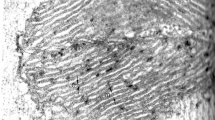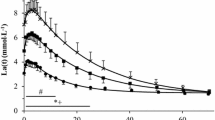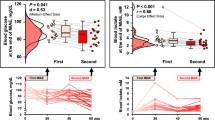Abstract
Tracers have been used extensively to study lactate metabolism in humans during rest and exercise. Nevertheless, quantification of in vivo lactate kinetics as measured by lactate tracers remains controversial and new data are necessary to clarify the issue. The present study has developed a simple kinetic model which does not require labelled molecules and which yields proportional and quantitative information on lactate metabolism in humans during postexercise recovery performed at different levels of intensity. Five subjects took part in six experiments each of which began with the same strenuous exercise (StrEx; 1 min, 385 W, 110 rpm). The StrEx of each session was followed by a different intensity of recovery: passive recovery (PR) and active recoveries (AR) with power outputs of 60, 90, 120, 150 and 180 W, respectively. Blood lactate concentration was measured prior to and immediately after StrEX and regularly during the 1st h of recovery. Oxygen uptake (\(\dot VO_2 \)) was measured every 30 s during the whole session. The results showed that the disappearance rate constant (ke) increases abruptly from PR [0.080 (SEM 0.004) min−1] to moderate AR [60W: 0.189 (SEM 0.039) min−1] and decreases slowly during more intense AR [180 W: 0.125 (SEM 0.027) min−1]. The lactate apparent clearance (Cl·F−1) was calculated from the area under the lactate concentration-time curve. The Cls·F−1 increased 1.81 (SEM 0.17) fold from PR to moderate AR (60 W) and only 1.31 (SEM 0.14) from PR to the most intense AR (180 W). Using the model, the apparent lactate production (F″K0) was also calculated. The F″K0 increased regularly following a slightly curvilinear function of\(\dot VO_2 \) and was 2.61 (SEM 0.53) fold greater during the most intense AR (180 W) than during PR. Because of the lack of data concerning the size of apparent lactate distribution volume (V d), the apparent turnover rate (Rbl) has been presented here related toV d. The Rbl·V −1d increased also following a slightly curvilinear function of\(\dot VO_2 \). The Rbl·V −1d was 85.90 (SEM 14.42) μmol·min−1·l−1 during PR and reached 314.09 (SEM 153.95) μmol·min−1·l−1 during the most intense AR (180 W). In conclusion the model presented here does not require labelled molecules and firstly makes it possible to follow the proportional change of apparent lactate clearance and apparent lactate production during active postexercise recovery in comparison with passive recovery conditions and secondly to estimate the blood lactate turnover.
Similar content being viewed by others
References
Belcastro AN, Bonen A (1975) Lactic acid removal rates during controlled and uncontrolled recovery exercise. J Appl Physiol 39:932–936
Binder ND, Day D, Battaglia FC, Meschia G, Sparks JW (1991) Role of circulation in measurement of lactate turnover rate. J Appl Physiol 70:1469–1476
Dood S, Powers SK, Callender T, Brooks E (1984) Blood lactate disappearance at various intensities of recovery exercise. J Appl Physiol 57:1462–1465
Francaux M, Jacqmin P, Sturbois X (1993) Variations in lactate apparent clearance during rest and exercise in normal man. Arch Int Physiol Biochim Biophys 101:303–309
Freund H, Zouloumian P (1981a) Lactate after exercise in man. I. Evolution kinetics in arterial blood. Eur J Appl Physiol 46:121–133
Freund H, Zouloumian P (1981b) Lactate after exercise in man. IV. Physiological observations and model predictions. Eur J Appl Physiol 46:161–176
Freund H, Oyono-Enguelle S, Heitz A, Marbach J, Ott C, Zouloumian P, Lampert E (1986) Work rate-dependent lactate kinetics after exercise in humans. J Appl Physiol 61:932–939
Hermansen L, Stensvold I (1972) Production and removal of lactate during exercise in man. Acta Physiol Scand 86:191–201
Katz J (1992) On the determination of turnover in vivo with tracers. Am J Physiol 263:E417-E424
Katz J, Wolfe RR (1988) On the measurement of lactate turnover in humans. Metab Clin Exp 37:1078–1080
MacRae HSH, Dennis SC, Bosch AN, Noakes TD (1992) Effects of training on lactate production and removal during progressive exercise in humans. J Appl Physiol 72:1649–1656
Mazzeo RS, Brooks GA, Schoeller DA, Budinger TF (1986) Disposal of [1–13C] lactate in humans during rest and exercise. J Appl Physiol 60:232–241
Nedler JA, Mead R (1965) A simplex method for function minimization. Comput J 4:308–313
Okajima F, Chenoweth M, Rognstad R, Dunn A, Katz J (1981) Metabolism of3H and14C-labelled lactate in starved rats. Biochem J 194:525–540
Sacca L, Toffolo G, Cobelli C (1992) V-A and A-V modes in whole body and regional kinetics domain of validity from a physiological model. Am J Physiol 263:E597-E606
Sahlin K (1987) Lactate production cannot be measured with tracer technique. Am J Physiol 252:E439-E440
Searle GL, Cavalieri RR (1972) Determination of lactate kinetics in the human: analysis of data from single injection and continuous infusion. Proc Soc Exp Biol Med 139:1002–1006
Stamford BA, Weltman A, Moffatt R, Stanley S (1981) Exercise recovery above and below anaerobic threshold following maximal work. J Appl Physiol 51:840–844
Stanley WC, Gertz EW, Wineski JA, Neese RA, Brooks GA (1985) Systemic lactate kinetics during graded exercise in man. Am J Physiol 249:E595-E602
Stanley WC, Gertz EW, Wineski JA, Neese RA, Morris DL, Brooks GA (1986) Lactate extraction during net lactate release in legs of humans during exercise. J Appl Physiol 60:1116–1120
Stanley WC, Wineski JA, Gertz ED, Neese RA, Morris DL, Brooks GA (1988) Glucose and lactate interactions during moderate intensity exercise in humans. Metabolism 37:850–858
Weltman K, Stamford BA, Fulco C (1979) Recovery from maximal effort exercise: lactate disappearance and subsequent performance. J Appl Physiol 47:677–682
Wilkinson, Leland (1989) SYSTAT: The system for statistics. SYSTAT, Inc., Evanston, Ill.
Zhang XJ, Baba H, Wolfe R (1993) Further evaluation of isotopic equilibrium between labeled pyruvate and lactate. J Nutr Biochem 4:218–221
Author information
Authors and Affiliations
Rights and permissions
About this article
Cite this article
Francaux, M., Jacqmin, P., de Welle, J.M. et al. A study of lactate metabolism without tracer during passive and active postexercise recovery in humans. Eur J Appl Physiol 72, 58–66 (1995). https://doi.org/10.1007/BF00964115
Accepted:
Issue Date:
DOI: https://doi.org/10.1007/BF00964115




